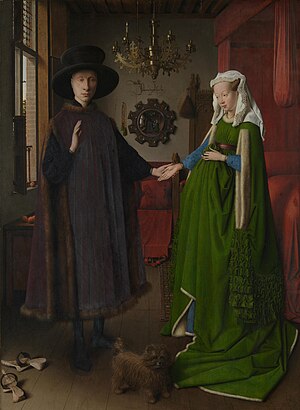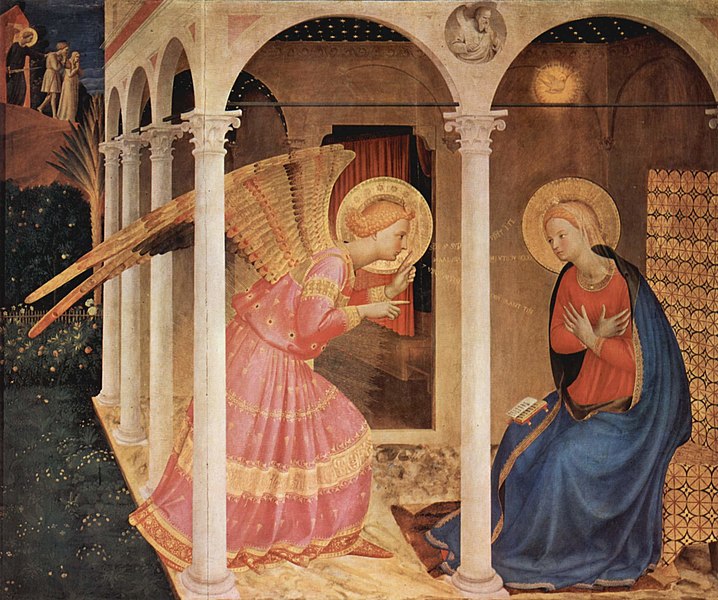All AP Art History Resources
Example Questions
Example Question #131 : Ap Art History
The painting shown in Figure 3 is an example of __________.
Baroque painting
Medieval painting
Mannerist painting
Renaissance painting
Medieval painting
Fra Angelico is considered one of the masters of devotional art from the Middle Ages. This painting, depicting an important scene from the Bible, exhibits many of the key features of such art. Both the angel and Mary have halos around their heads and are placed in a flat space, and important symbolism is used.
Figure 3: The Annunciation (Cortona) by Fra Angelico (1433)
Figure 4: Supper at Emmaus (Milan) by Caravaggio (1606)
Example Question #62 : Fourteenth Through Sixteenth Century 2 D Art
The wall fresco behind the altar of the Sistine Chapel in Rome known as The Last Judgement was painted by __________.
Leonardo da Vinci
Titian
Sandro Botticelli
Michelangelo
Michelangelo
The Last Judgement takes up the entire altar wall in the Sistine Chapel with a scene depicting human souls being judged by Christ while surrounded by a number of saints. Michelangelo's masterful composition and stunning portraiture make this painting one of his masterpieces, along with the painting of the ceiling of the Sistine Chapel. The painting has not been without controversy, however, as Michelangelo depicted the souls in judgement as nudes, which both showed them as equals and violated decorum.
Example Question #132 : Ap Art History
The Catholic saint often portrayed in art with simple robes and accompanied by birds is __________.
Pope Saint Pius V
Saint Ignatius of Loyola
Saint Francis of Assisi
Saint Patrick of Ireland
Saint Francis of Assisi
Francis of Assisi was a minor Italian nobleman of the late twelfth and early thirteenth centuries who took a vow of asceticism and became influential as a monastic reformer and the founder of the Franciscan Order. Francis of Assisi became hugely popular in the Counter Reformation and therefore in Baroque art. Francis of Assisi can be identified in art by his plain brown robes and the birds and animals that usually are flocking around him.
Example Question #61 : Fourteenth Through Sixteenth Century 2 D Art

Pictured above is the Arnolfini Portrait, and can be found at the Website of National Gallery, London.
In commemoration of what event was this portrait painted?
The birth of a noble child
The death of a family member
A Danish festival
A wedding
A court event
A wedding
The joining of their hands, the headdress the woman wears and the position of the woman nearer to the bed are all symbolic of a union of marriage between these two people.
Example Question #134 : Ap Art History
Which painter created the portrait of Holy Roman Emperor Charles V on horseback that commemorated the Imperial victory at the Battle of Mühlberg?
Peter Breughel
Michelangelo
Titian
Caravaggio
Titian
The Equestrian Portrait of Charles V, which includes the actual horse and armor the Emperor used at Mühlberg, is one of Titian's most famous and significant works. The painting combined a realistic foreground of the emperor and his horse with a more airy background, while containing little of the symbolic elements typical of paintings of the era. Titian's painting became a template for many later portraits of monarchs in equestrian poses.
Example Question #131 : Ap Art History
The Early Netherlandish painter who made the panel painting known as The Descent from the Cross was __________.
Roger van der Weyden
Jan van Eyck
Hieronymous Bosch
Hans Memling
Roger van der Weyden
Rogier van der Weyden created the famous panel of The Descent from the Cross in 1435. The work features the rich colors and portraiture representative of much Early Netherlandish art, but also focuses the viewer's attention to the scene's humanity while simultaneously emphasizing the religious nature of the image. The effective combination of these two elements would prove hugely influential to Italian Renaissance painters.
Example Question #61 : Fourteenth Through Sixteenth Century 2 D Art
Which of the following was the official court painter for Henry VIII of England, and in that role created famous portraits of Anne Boleyn, Thomas More, and Thomas Cromwell?
Albrecht Durer
Hans Holbein the Younger
Joachim Wtewael
Pieter Breugel the Elder
Hans Holbein the Younger
Hans Holbein the Younger is referred to with the suffix to differentiate him from his father, who was a painter of the Late Gothic school. Holbein the Younger was an innovator in the Northern Renaissance style, beginning in Germany and then moving to England to become the official painter for the court of King Henry VIII. There, he made significant advances to the art of portraiture with his paintings of the important figures of the court life in England.
Example Question #492 : Clep: Humanities
The artist Michelangelo was key to the development of __________ art.
Baroque
Renaissance
Rococco
Post-impressionistic
Impressionistic
Renaissance
Michelangelo (1475-1564) is often considered the prototypical "Renaissance man," along with Leonardo da Vinci, thanks to his key involvement in painting, sculpture, and design. Michelangelo was one of the earliest painters to use realistic imagery, forced perspective, and an enhanced use of color. His work was key in the development of Renaissance themes like a return to classical motifs, a sense of grandeur, and the use of scientific knowledge in the arts.
Example Question #3 : Identifying Artists, Works, And Schools Of Renaissance 2 D Visual Art
Who was the fifteenth-century Flemish painter who painted the massive Ghent Altarpiece?
Rembrandt van Rijn
Hans Holbein
Hieronymus Bosch
Michelangelo
Jan van Eyck
Jan van Eyck
Jan van Eyck was a transformative figure in European painting, as his approach to painting depended on realism and a naturalistic viewpoint. His Ghent Altarpiece, also called The Lamb of God, was a departure from Medieval standards that typically valued idealization and symbolism in religious imagery. Van Eyck, who lived from 1390 to 1441, had an outsized influence on the artistic transformations that occurred during the Renaissance.
Example Question #2 : Identifying Artists, Works, And Schools Of Renaissance 2 D Visual Art
The painter well known for portraits of the court of Henry VIII of England is __________.
Titian
Rembrandt van Rijn
Anthony van Dyck
Hans Holbein the Younger
Lucas Cranach the Elder
Hans Holbein the Younger
Hans Holbein the Younger made a name for himself by painting nearly every figure associated with the court of the English king Henry VIII. In doing so, he helped pioneer a new use of perspective in his portraits. Holbein's work helped push Renaissance art to new places simply through portraits.
Certified Tutor
Certified Tutor
All AP Art History Resources





